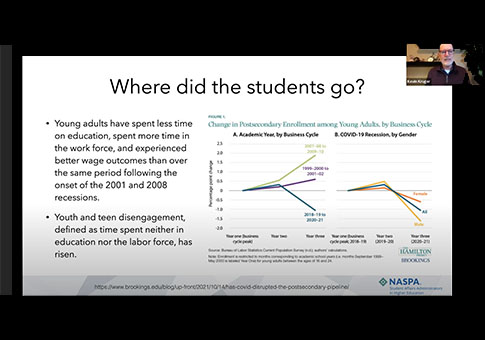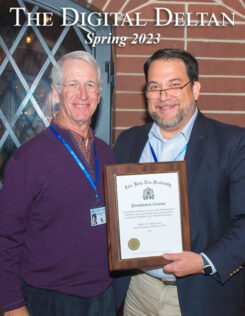Features
How COVID-19 is Still Shaping Higher Education
Issue: Fall 2022

Higher education today looks very different than even the most recent graduates would know. The lingering impact of the COVID-19 pandemic to today’s college student at what is a very formative time in their lives is highly influential in understanding the current status of ZBT undergraduates and chapters.
Fraternity Executives Association recently hosted a webinar presented by Kevin Kruger, president of National Association of Student Personnel Administrators. NASPA is the professional home for the field of student affairs, the overarching term for all higher education experiences that happen outside a classroom. Fraternity and sorority membership, residence life, student government, campus organizations and other similar areas fall into the student affairs category. As you can imagine, NASPA leaders and members work closely with fraternity professionals across the United States.
Kruger shared an overview of recent research related to the pandemic’s impact on campuses and students.
Enrollment
- Before the pandemic, 2026 was targeted as the year when a major higher education enrollment decline was expected, based on a decline in birth rate during the 2008 recession. The COVID-19 pandemic, however, has escalated the timeline for that trend and nationally higher education enrollment has been trending downward since fall 2020.
- The rate of high school graduates continuing their education has decreased over the past two years. Young people are choosing paths other than college, notably an earlier entrance to the work force, and also many are choosing to take no action – deferring all choices.
Additional reading: Spring 2022 enrollment down 4.1% (National Student Clearinghouse Research Center). Synopsis: The incredible shrinking future of college (Vox).
Politics and activism
- Students who choose an in-person higher education experience are politically motivated and highly interested in activism. The political views of Generation Z — those born after 1997, so age 24 and younger — fall to the extreme ends of the spectrum. Fewer students identify as moderate than previous generations.
- University administrations are seen as having highly targeted political ideologies and taking politically motivated actions. This reputation is influencing the decisions of potential and current students.
- International enrollment has declined by approximately 21 percent (according to Higher Ed Dive) since the start of the global pandemic.
Additional reading: The Growing Partisan Divide in Views of Higher Education (Pew Research Center).
Climate and culture
- Surveys of current students show they do not like virtual learning, but that data can seem misleading. They strongly want an on-campus living experience and in-person interactions through campus spaces, but they do not prefer classes in person, they prefer remote education. Kruger explained this anecdotally: They don’t want to get ready and go to an 8 a.m. class but they do want to live in a fraternity house with their friends.
- The pandemic has caused some issues with delayed adolescence. “When I say ‘delayed adolescent,’ I mean that while they are now back in the classroom, a lot of the normal interactions they’d have had in their junior or senior year of high school were canceled. What we’re observing is the normal developmental things that occur in high school are being pushed back into the college years.” This will have an impact on fraternity recruitment and the types of students who are interested in a fraternity experience, he added.
- Overall student mental health is similar, comparing 2019 pre-pandemic to 2021. Students feel the same stressors and report the same levels of markers like anxiety and depression.
- Career development and improvement is what students most expect to get out of a college degree. Professional satisfaction is an influential factor — 90% of Gen Z workers report they are looking for a new job.
Additional reading: The post-pandemic Gen Z (Open Campus)
Staffing and stability
- Generally, institutions with a long history, superior reputation and large alumni base are weathering the pandemic best. Smaller schools and for-profit institutions have seen greater challenges and enrollment losses. Institutions in warmer locations are faring better than those in colder climates.
- Higher education as an industry has a good financial picture. Credit agencies rate the industry as stable and most institutions are not facing major budget issues.
- The service functions of the institutions such as dining halls and maintenance teams are facing staffing challenges, similar to those seen by much of the world. The student workforce is depleted; many students are not interested in low-wage service jobs.
- Professional staff in higher education are disillusioned and overextended, including student affairs and fraternity life professionals. Graduate school enrollment in higher education also has declined so entry level professional staff are difficult to find.
- The relationships between the institution and between the student affairs departments are good, despite the challenges. “(Administrators see us playing a critical role in how institutions survived the pandemic,” Kruger said. Student affairs professionals, including fraternities, “were at the front line of almost all the crisis management COVID-19 pandemic, whether it be testing or quarantining or strategies to help students be successful. As a result of that, student affairs professionals’ stock is pretty high. There’s now a greater acknowledgment that the things that are taking place in your chapters are critically important to how students experience their institution.”
Additional reading: Higher Education’s Role in the Era of the Great Resignation (Inside Higher Ed)
 Fall 2024
Fall 2024  Spring 2024
Spring 2024  Fall 2023
Fall 2023  Spring 2023
Spring 2023 